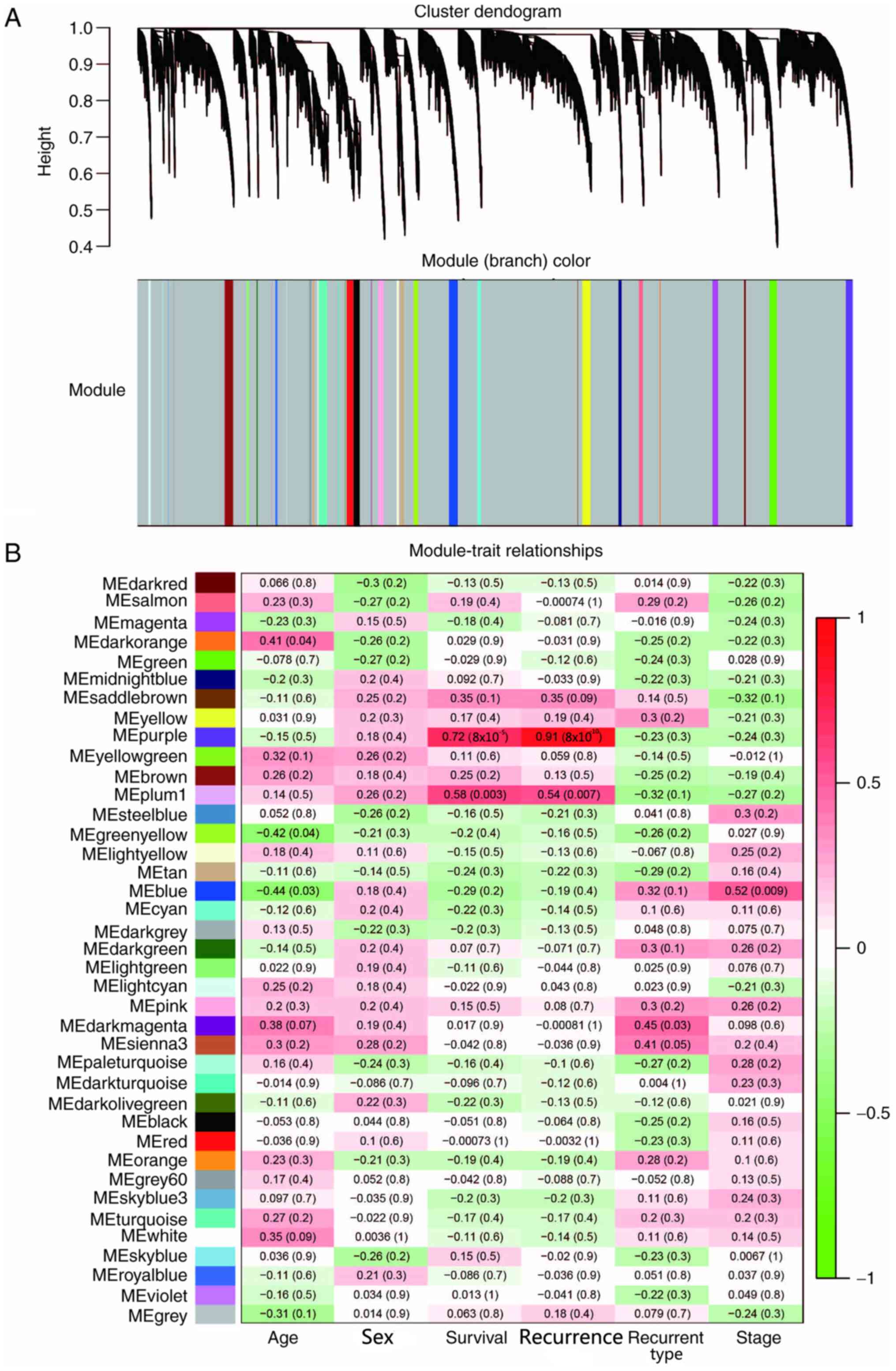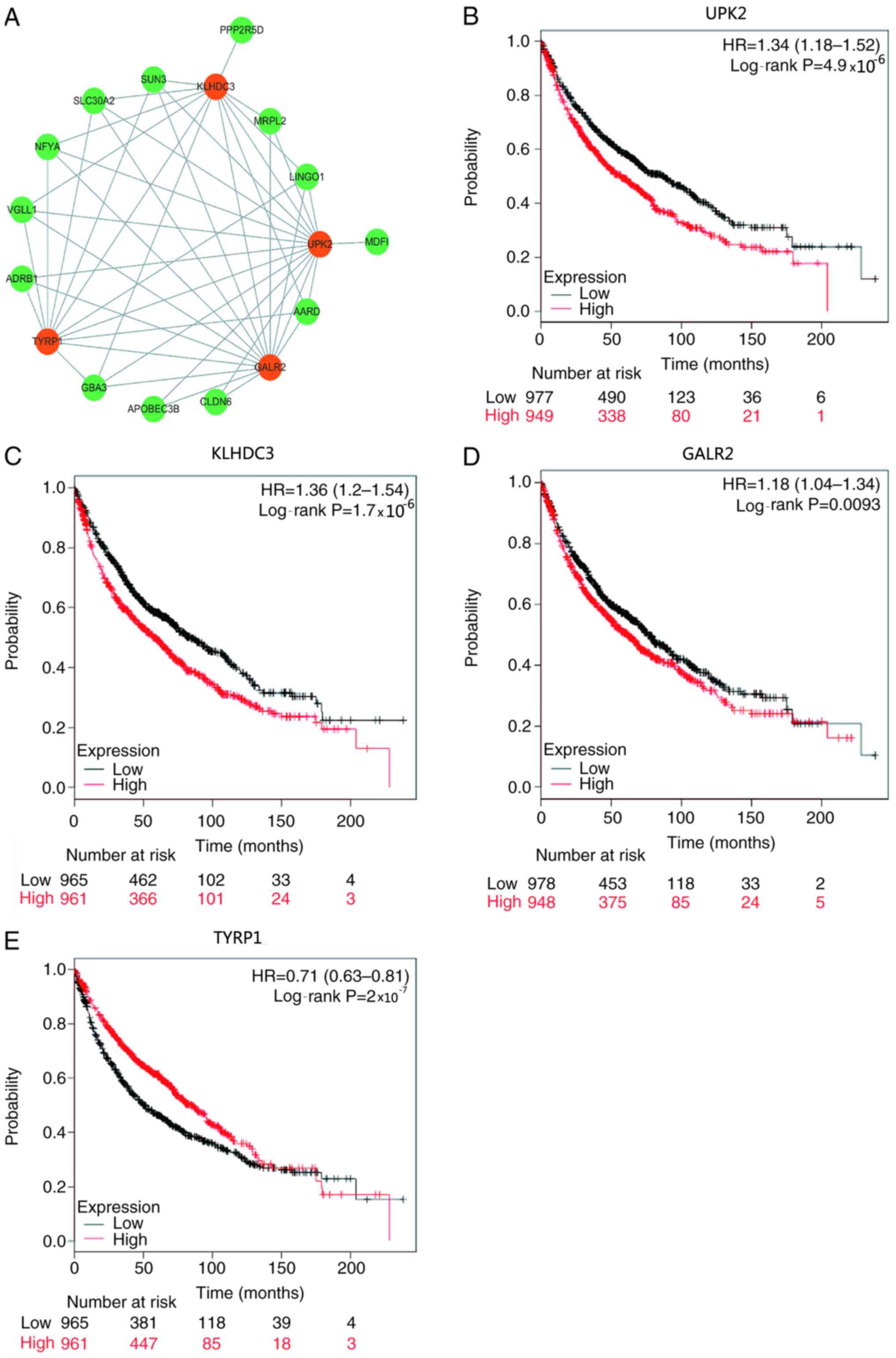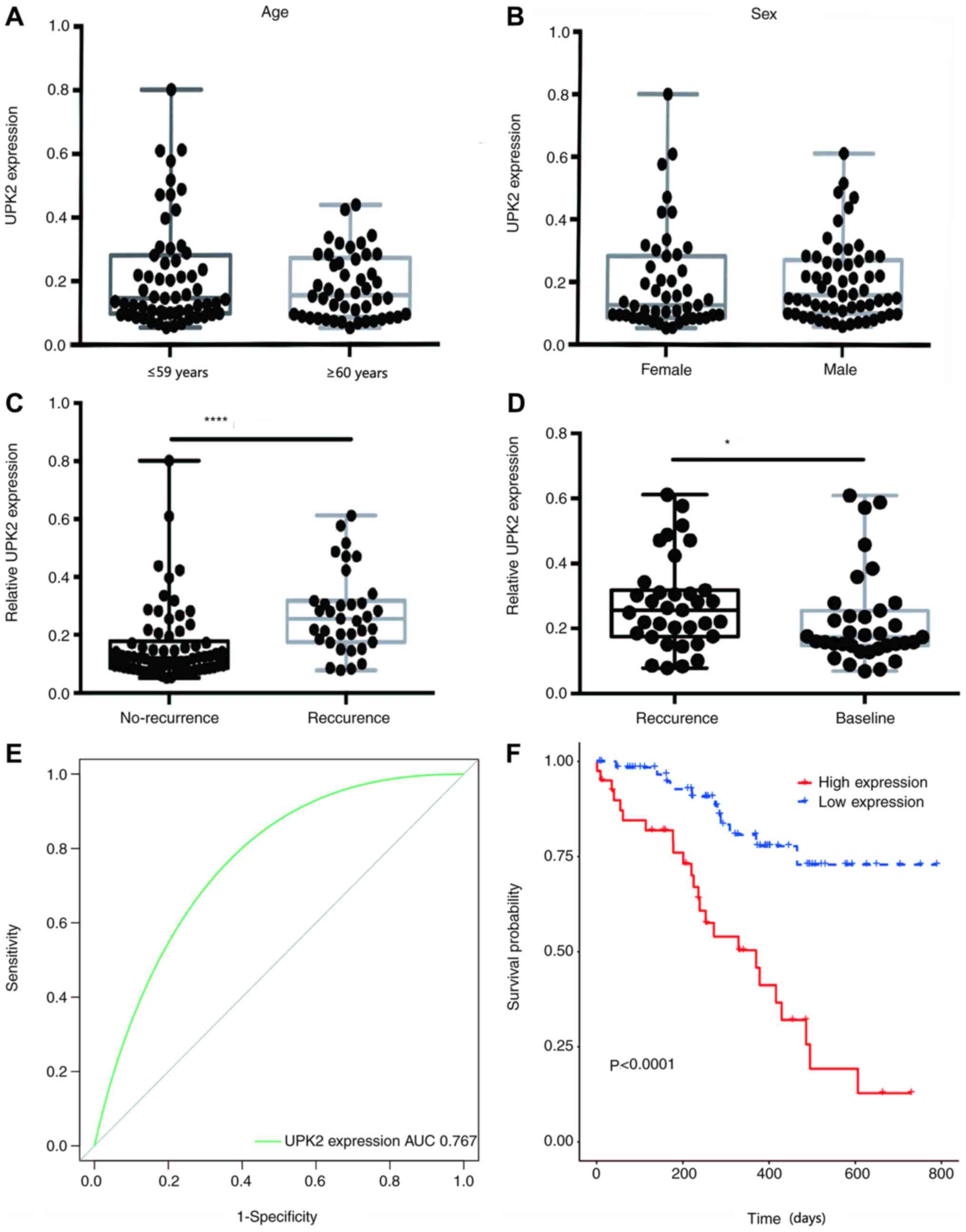|
1
|
Zhu Y, Xing P, Wang S, Ma D, Mu Y, Li X,
Xu Z and Li J: Evaluation of calculating carboplatin dosage in
carboplatin-pemetrexed therapy as the first-line therapy for
Chinese patients with advanced lung adenocarcinoma. Thorac Cancer.
9:400–407. 2018. View Article : Google Scholar : PubMed/NCBI
|
|
2
|
Liu AN, Qu HJ, Yu CY and Sun P: Knockdown
of LINC01614 inhibits lung adenocarcinoma cell progression by
up-regulating miR-217 and down-regulating FOXP1. J Cell Mol Med.
22:4034–4044. 2018. View Article : Google Scholar : PubMed/NCBI
|
|
3
|
Zhou X, Zhang P, Luo W, Zhang L, Hu R, Sun
Y and Jiang H: Ketamine induces apoptosis in lung adenocarcinoma
cells by regulating the expression of CD69. Cancer Med. 7:788–795.
2018. View Article : Google Scholar : PubMed/NCBI
|
|
4
|
Han B, Jin B, Chu T, Niu Y, Dong Y, Xu J,
Gu A, Zhong H, Wang H, Zhang X, et al: Combination of chemotherapy
and gefitinib as first-line treatment for patients with advanced
lung adenocarcinoma and sensitive EGFR mutations: A randomized
controlled trial. Int J Cancer. 141:1249–1256. 2017. View Article : Google Scholar : PubMed/NCBI
|
|
5
|
Zhuang X, Qiao T, Xu G, Yuan S, Zhang Q
and Chen X: Combination of nadroparin with radiotherapy results in
powerful synergistic antitumor effects in lung adenocarcinoma A549
cells. Oncol Rep. 36:2200–2206. 2016. View Article : Google Scholar : PubMed/NCBI
|
|
6
|
Noronha V, Zanwar S, Joshi A, Patil VM,
Mahajan A, Janu A, Agarwal JP, Bhargava P, Kapoor A and Prabhash K:
Practice patterns and outcomes for pemetrexed plus platinum doublet
as neoadjuvant chemotherapy in adenocarcinomas of lung: Looking
beyond the usual paradigm. Clin Oncol (R Coll Radiol). 30:23–29.
2018. View Article : Google Scholar : PubMed/NCBI
|
|
7
|
Marini KD, Croucher DR, McCloy RA,
Vaghjiani V, Gonzalez-Rajal A, Hastings JF, Chin V, Szczepny A,
Kostyrko K, Marquez C, et al: Inhibition of activin signaling in
lung adenocarcinoma increases the therapeutic index of platinum
chemotherapy. Sci Transl Med. 10:eaat35042018. View Article : Google Scholar : PubMed/NCBI
|
|
8
|
Tao H, Meng Q, Li M, Shi L, Tang J and Liu
Z: Outcomes of bevacizumab combined with chemotherapy in lung
adenocarcinoma-induced malignant pleural effusion. Thorac Cancer.
9:298–304. 2018. View Article : Google Scholar : PubMed/NCBI
|
|
9
|
Wu K, Zhang X, Li F, Xiao D, Hou Y, Zhu S,
Liu D, Ye X, Ye M, Yang J, et al: Frequent alterations in
cytoskeleton remodelling genes in primary and metastatic lung
adenocarcinomas. Nat Commun. 6:101312015. View Article : Google Scholar : PubMed/NCBI
|
|
10
|
Wang X, Xu W, Zhan P, Xu T, Jin J, Miu Y,
Zhou Z, Zhu Q, Wan B, Xi G, et al: Overexpression of geranylgeranyl
diphosphate synthase contributes to tumour metastasis and
correlates with poor prognosis of lung adenocarcinoma. J Cell Mol
Med. 22:2177–2189. 2018. View Article : Google Scholar : PubMed/NCBI
|
|
11
|
Zhao S, Guo W, Li J, Yu W, Guo T, Deng W
and Gu C: High expression of Y-box-binding protein 1 correlates
with poor prognosis and early recurrence in patients with small
invasive lung adenocarcinoma. Onco Targets Ther. 9:2683–2692. 2016.
View Article : Google Scholar : PubMed/NCBI
|
|
12
|
Mansoori B, Mohammadi A, Davudian S,
Shirjang S and Baradaran B: The different mechanisms of cancer drug
resistance: A brief review. Adv Pharm Bull. 7:339–348. 2017.
View Article : Google Scholar : PubMed/NCBI
|
|
13
|
Zhang C, Leighl NB, Wu YL and Zhong WZ:
Emerging therapies for non-small cell lung cancer. J Hematol Oncol.
12:452019. View Article : Google Scholar : PubMed/NCBI
|
|
14
|
Aramini B, Casali C, Stefani A, Bettelli
S, Wagner S, Sangale Z, Hughes E, Lanchbury JS, Maiorana A and
Morandi U: Prediction of distant recurrence in resected stage I and
II lung adenocarcinoma. Lung Cancer. 101:82–87. 2016. View Article : Google Scholar : PubMed/NCBI
|
|
15
|
Krishnamurthy J, Torrice C, Ramsey MR,
Kovalev GI, Al-Regaiey K, Su L and Sharpless NE: Ink4a/Arf
expression is a biomarker of aging. J Clin Invest. 114:1299–1307.
2004. View
Article : Google Scholar : PubMed/NCBI
|
|
16
|
Shaw LM, Vanderstichele H, Knapik-Czajka
M, Clark CM, Aisen PS, Petersen RC, Blennow K, Soares H, Simon A,
Lewczuk P, et al: Cerebrospinal fluid biomarker signature in
Alzheimer's disease neuroimaging initiative subjects. Ann Neurol.
65:403–413. 2009. View Article : Google Scholar : PubMed/NCBI
|
|
17
|
Ji X, Takahashi R, Hiura Y, Hirokawa G,
Fukushima Y and Iwai N: Plasma miR-208 as a biomarker of myocardial
injury. Clin Chem. 55:1944–1949. 2009. View Article : Google Scholar : PubMed/NCBI
|
|
18
|
Plotti F, Capriglione S, Terranova C,
Montera R, Aloisi A, Damiani P, Muzii L, Scaletta G,
Benedetti-Panici P and Angioli R: Does HE4 have a role as biomarker
in the recurrence of ovarian cancer? Tumour Biol. 33:2117–2123.
2012. View Article : Google Scholar : PubMed/NCBI
|
|
19
|
Huang Y, Cen J, Wei J, Chen Z, Fang Y,
Feng Z, Lu J, Liang Y, Luo J, Mo C and Chen W: Impact of AIB1
expression on the prognosis of upper tract urothelial carcinoma
after radical nephroureterectomy. Cancer Biomark. 25:151–160. 2019.
View Article : Google Scholar : PubMed/NCBI
|
|
20
|
Sgroi DC, Carney E, Zarrella E, Steffel L,
Binns SN, Finkelstein DM, Szymonifka J, Bhan AK, Shepherd LE, Zhang
Y, et al: Prediction of late disease recurrence and extended
adjuvant letrozole benefit by the HOXB13/IL17BR biomarker. J Natl
Cancer Inst. 105:1036–1042. 2013. View Article : Google Scholar : PubMed/NCBI
|
|
21
|
Ni KW and Sun GZ: The identification of
key biomarkers in patients with lung adenocarcinoma based on
bioinformatics. Math Biosci Eng. 16:7671–7687. 2019. View Article : Google Scholar : PubMed/NCBI
|
|
22
|
Li R, Yang YE, Yin YH, Zhang MY, Li H and
Qu YQ: Methylation and transcriptome analysis reveal lung
adenocarcinoma-specific diagnostic biomarkers. J Transl Med.
17:3242019. View Article : Google Scholar : PubMed/NCBI
|
|
23
|
Langfelder P and Horvath S: WGCNA: An R
package for weighted correlation network analysis. BMC
Bioinformatics. 9:5592008. View Article : Google Scholar : PubMed/NCBI
|
|
24
|
Langfelder P and Horvath S: Fast R
functions for robust correlations and hierarchical clustering. J
Stat Softw. 46:i112012. View Article : Google Scholar : PubMed/NCBI
|
|
25
|
Livak KJ and Schmittgen TD: Analysis of
relative gene expression data using real-time quantitative PCR and
the 2(-Delta Delta C(T)) method. Methods. 25:402–408. 2001.
View Article : Google Scholar : PubMed/NCBI
|
|
26
|
Robin X, Turck N, Hainard A, Tiberti N,
Lisacek F, Sanchez JC and Müller M: pROC: An open-source package
for R and S+ to analyze and compare ROC curves. BMC Bioinformatics.
12:772011. View Article : Google Scholar : PubMed/NCBI
|
|
27
|
Yu L, Tao G, Zhu L, Wang G, Li Z, Ye J and
Chen Q: Prediction of pathologic stage in non-small cell lung
cancer using machine learning algorithm based on CT image feature
analysis. BMC Cancer. 19:4642019. View Article : Google Scholar : PubMed/NCBI
|
|
28
|
Mähler N, Wang J, Terebieniec BK,
Ingvarsson PK, Street NR and Hvidsten TR: Gene co-expression
network connectivity is an important determinant of selective
constraint. PLoS Genet. 13:e10064022017. View Article : Google Scholar
|
|
29
|
Miura N, Hasegawa J and Shiota G: Serum
messenger RNA as a biomarker and its clinical usefulness in
malignancies. Clin Med Oncol. 2:511–527. 2008.PubMed/NCBI
|
|
30
|
Tani N, Ichikawa D, Ikoma D, Tomita H, Sai
S, Ikoma H, Okamoto K, Ochiai T, Ueda Y, Otsuji E, et al:
Circulating cell-free mRNA in plasma as a tumor marker for patients
with primary and recurrent gastric cancer. Anticancer Res.
27:1207–1212. 2007.PubMed/NCBI
|
|
31
|
Siegel RL, Miller KD and Jemal A: Cancer
statistics, 2017. CA Cancer J Clin. 67:7–30. 2017. View Article : Google Scholar : PubMed/NCBI
|
|
32
|
Youlden DR, Cramb SM and Baade PD: The
international epidemiology of lung cancer: Geographical
distribution and secular trends. J Thorac Oncol. 3:819–831. 2008.
View Article : Google Scholar : PubMed/NCBI
|
|
33
|
Rosell R, Bivona TG and Karachaliou N:
Genetics and biomarkers in personalisation of lung cancer
treatment. Lancet. 382:720–731. 2013. View Article : Google Scholar : PubMed/NCBI
|
|
34
|
Hung JJ, Yeh YC, Jeng WJ, Wu KJ, Huang BS,
Wu YC, Chou TY and Hsu WH: Predictive value of the international
association for the study of lung cancer/American Thoracic
Society/European Respiratory Society classification of lung
adenocarcinoma in tumor recurrence and patient survival. J Clin
Oncol. 32:2357–2364. 2014. View Article : Google Scholar : PubMed/NCBI
|
|
35
|
Subramaniam S, Thakur RK, Yadav VK, Nanda
R, Chowdhury S and Agrawal A: Lung cancer biomarkers: State of the
art. J Carcinog. 12:32013. View Article : Google Scholar : PubMed/NCBI
|
|
36
|
Remon J, Moran T, Reguart N, Majem M,
Carcereny E and Lianes P: Beyond EGFR TKI in EGFR-mutant non-small
cell lung cancer patients: Main challenges still to be overcome.
Cancer Treat Rev. 40:723–729. 2014. View Article : Google Scholar : PubMed/NCBI
|
|
37
|
Soda M, Choi YL, Enomoto M, Takada S,
Yamashita Y, Ishikawa S, Fujiwara S, Watanabe H, Kurashina K,
Hatanaka H, et al: Identification of the transforming EML4-ALK
fusion gene in non-small-cell lung cancer. Nature. 448:561–566.
2007. View Article : Google Scholar : PubMed/NCBI
|
|
38
|
Bergethon K, Shaw AT, Ou SH, Katayama R,
Lovly CM, McDonald NT, Massion PP, Siwak-Tapp C, Gonzalez A, Fang
R, et al: ROS1 rearrangements define a unique molecular class of
lung cancers. J Clin Oncol. 30:863–870. 2012. View Article : Google Scholar : PubMed/NCBI
|
|
39
|
Li SM, Zhang ZT, Chan S, McLenan O, Dixon
C, Taneja S, Lepor H, Sun TT and Wu XR: Detection of circulating
uroplakin-positive cells in patients with transitional cell
carcinoma of the bladder. J Urol. 162((3 Pt 1)): 931–935. 1999.
View Article : Google Scholar : PubMed/NCBI
|
|
40
|
Lotan TL, Ye H, Melamed J, Wu XR, Shih IM
and Epstein JI: Immunohistochemical panel to identify the primary
site of invasive micropapillary carcinoma. Am J Surg Pathol.
33:1037–1041. 2009. View Article : Google Scholar : PubMed/NCBI
|
|
41
|
Li W, Liang Y, Deavers MT, Kamat AM, Matin
SF, Dinney CP, Czerniak B and Guo CC: Uroplakin II is a more
sensitive immunohistochemical marker than uroplakin III in
urothelial carcinoma and its variants. Am J Clin Pathol.
142:864–871. 2014. View Article : Google Scholar : PubMed/NCBI
|
|
42
|
Matuszewski M, Szymanska B, Dlugosz A,
Malkiewicz B, Dembowski J and Piwowar A: Preliminary evaluation of
the diagnostic usefulness of uroplakin 2 with an assessment of the
antioxidant potential of patients with bladder cancer. Biomed Res
Int. 2018:86932972018. View Article : Google Scholar : PubMed/NCBI
|
|
43
|
Tian W, Guner G, Miyamoto H,
Cimino-Mathews A, Gonzalez-Roibon N, Argani P, Li X, Sharma R,
Subhawong AP, Rezaei K, et al: Utility of uroplakin II expression
as a marker of urothelial carcinoma. Hum Pathol. 46:58–64. 2015.
View Article : Google Scholar : PubMed/NCBI
|
|
44
|
Hoang LL, Tacha D, Bremer RE, Haas TS and
Cheng L: Uroplakin II (UPII), GATA3, and p40 are highly sensitive
markers for the differential diagnosis of invasive urothelial
carcinoma. Appl Immunohistochem Mol Morphol. 23:711–716. 2015.
View Article : Google Scholar : PubMed/NCBI
|


















